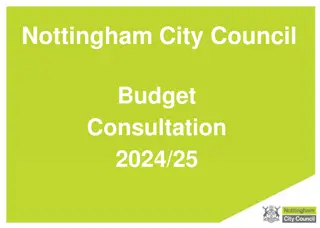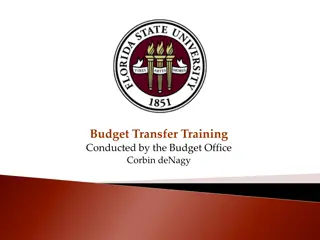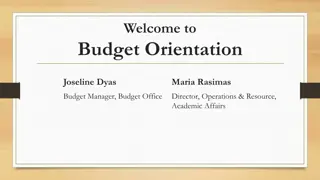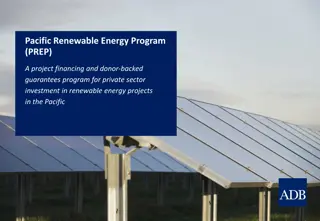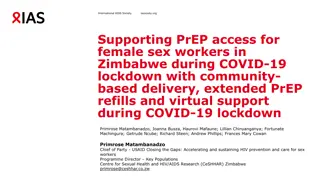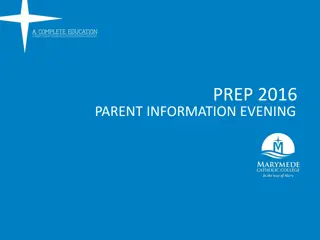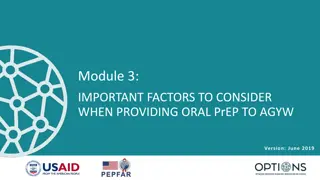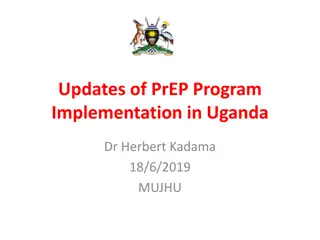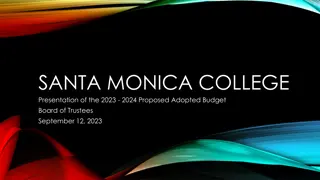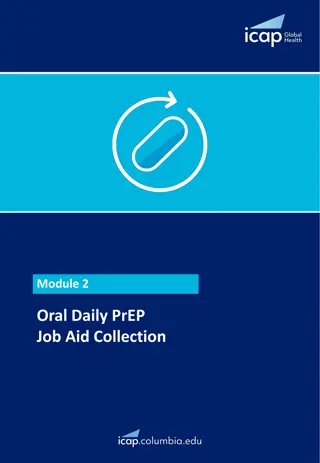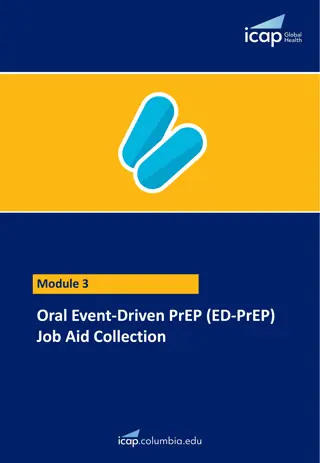
Funding Allocation and Budget Analysis
Explore a comprehensive overview of funding allocation, revenue sources, and operating budgets for a college institution. Delve into key areas such as state funding, tuition fees, international programs, and more to understand financial trends and strategic planning for the educational institution. Dive into detailed insights on budgeted funding sources, revenue budgets vs. actuals, and income sources for the academic year. Gain valuable information on resource allocation strategies and financial decision-making processes within the institution.
Download Presentation

Please find below an Image/Link to download the presentation.
The content on the website is provided AS IS for your information and personal use only. It may not be sold, licensed, or shared on other websites without obtaining consent from the author. If you encounter any issues during the download, it is possible that the publisher has removed the file from their server.
You are allowed to download the files provided on this website for personal or commercial use, subject to the condition that they are used lawfully. All files are the property of their respective owners.
The content on the website is provided AS IS for your information and personal use only. It may not be sold, licensed, or shared on other websites without obtaining consent from the author.
E N D
Presentation Transcript
Institutional Finance$ andFUN FUNds College Council Resource Allocation Subcommittee
Agenda and Outcomes 1. Operating budget overview 2. State appropriation and system allocation 3. State funding and enrollment trends 4. FY 18-19: Additional context and district priorities 5. Questions & Answers
The Big Picture Operating Budget Self Support & Enterprise Foundation Funded Grant Funded Capital Budget National Science Foundation International Programs Minor & Major Projects Instruction Professional Development Student Services Carl D. Perkins Repair & Program Improvement Parking Administrative Services WorkFirst Auxiliary Services Food, Copy, Rent Scholarships Institutional Management Department of Education M&O Funding
16 17 Revenue Budget vs Actual Revenue Source FY17 Forecast FY17 Actual Year-end % Operating Fee (tuition) $10,415,682 $10,215,682 98% S&A Fee $1,127,000 $1,315,889 117% Technology Fee $576,962 $587,060 102% Running Start $1,319,893 $1,813,879 137% International $18,896,754 $19,341,583 102% eLearning $115,382 $127,057 110% Continuing Education $255,472 $292,264 114% Auxiliary Services $3,454,235 $3,778,986 109%
2017-18 Income by Funding Sources * Running Start, International Programs, eLearning, Foundation, and other enterprises
2017-18 Operating Budget $4M operating budget based on: FTE Assumptions: 4,843 regular state-funded (compared to 4,989 in 16-17) 680 Running Start (compared to 459 in 16-17) 1,032 International Programs (compared to 1,114 in 16-17) Basically overall flat enrollment Conservative approach Some growth in targeted disciplines/programs 2% increase in resident tuition
2017-18 Budgeted Funding Sources Fund Source 2016-2017 2017-2018 State Appropriation $23,541,209 $22,487,872 Operating Fee (tuition) $10,215,682 $10,661,118 Local Funds (Cost Recovery/Contract Funds from International and Running Start) $10,013,614 $10,152,753 Fund Reserves (IP Temp Allotment) $2,500,000 - Carryforward (Net) $3,572,505 $ 4,468,520 TOTAL ALLOCATION $49,843,011 $47,770,263 Total Expenditures $44,931,005 Operating Balance (Carryforward (gross)) $4,882,006
Seattle Central 2017-18 Expenditure by Cost Center
Agenda and Outcomes 1. Operating budget overview 2. State appropriation and system allocation 3. State funding and enrollment trends 4. FY 18-19: Additional context and district priorities 5. Questions & Answers
State Allocation Formula Minimum Operating Allowance (MOA) District Enrollment Allocation Base (DEAB=state FTE target) Student Achievement Initiative (SAI=performance funding) High priority (high demand) enrollment weighted FTE Provisos and earmarks Total District (College) Allocation
State Allocation Formula Minimum Operating Allowance (MOA) District Enrollment Allocation Base (DEAB) Student Achievement Initiative (SAI) High priority (high demand) enrollment weighted FTE E N R O L L M E N T Provisos and earmarks Total District (College) Allocation
Agenda and Outcomes 1. Operating budget overview 2. State appropriation and system allocation 3. State funding and enrollment trends 4. FY 18-19: Additional context and district priorities 5. Questions & Answers
Historic CTC Funding by Account Inflation Adjusted by Seattle CPI $1,800,000 $1,600,000 $1,400,000 $1,200,000 $1,000,000 $800,000 $600,000 $400,000 $200,000 $- FY 2009 FY 2010 FY 2011 FY 2012 FY 2013 FY 2014 FY 2015 FY 2016 FY 2017 FY 2018 FY 2019 State Funds 145 148 149
Seattle CPI Base Year: 2018 Washington Community and Technical College System $ in thousands Annual Expenditures in Constant Dollars* Budgeted* FY 2009 FY 2010 FY 2011 FY 2012 FY 2013 FY 2014 FY 2015 FY 2016 FY 2017 FY 2018 FY 2019 State Funds 831,491 796,726 754,921 651,400 622,685 671,246 653,056 707,156 734,579 722,989 729,145 145 228,971 230,138 254,153 259,898 260,338 245,728 266,362 278,128 297,996 242,222 243,587 148 99,718 130,404 158,863 167,055 160,788 154,908 152,907 146,393 140,652 145,356 141,934 149 279,077 302,105 339,502 346,182 369,986 379,744 386,768 384,045 368,402 351,553 366,258 1,439,256 1,459,372 1,507,438 1,424,535 1,413,798 1,451,626 1,459,093 1,515,722 1,541,629 1,462,120 1,480,925 Total FY 2009 FY 2010 FY 2011 FY 2012 FY 2013 FY 2014 FY 2015 FY 2016 FY 2017 FY 2018 FY 2019 NGF-S 58% 55% 50% 46% 44% 46% 45% 47% 48% 49% 49% 145 16% 16% 17% 18% 18% 17% 18% 18% 19% 17% 16% 148 7% 9% 11% 12% 11% 11% 10% 10% 9% 10% 10% 149 19% 21% 23% 24% 26% 26% 27% 25% 24% 24% 25% -3% -5% -4% -2% 2% -1% 2% 1% 2% 0% Annual % Change in State Support -9% -3% -8% -12% -14% -12% -13% -11% -10% -8% Cumulative % Change in State Support Cumulative 0% 1% 1% 0% -1% 1% 0% 1% -3% 0% 1% Annual % Change in 145 2% 2% 1% 0% -1% 0% -1% -1% 1% 0% 3% Annual % Change in 148 1% 2% 2% 2% 0% 0% -1% -1% 0% 1% 5% Annual % Change in 149 *Adjusted by Seattle CPI, Base Year 2018.
Seattle Central Enrollment Trends State Target State Contract 7000 6101 5739 5424 6000 5484 5246 5000 5480 5484 5446 5049 4989 4000 3000 2000 1736 1864 1733 1000 1591 1282 0 2012-13 2013-14 2014-15 2015-16 2016-17
Agenda and Outcomes 1. Operating budget overview 2. State appropriation and system allocation 3. State funding and enrollment trends 4. FY 18-19: Additional context and district priorities 5. Questions & Answers
Additional Context & Considerations 35% of the 2% COLA increase (-$265K) Year 3 of the allocation model phase in (-684K) 2% tuition increase (+365K) Increase in running start students ($+500K) Increase in district office spending (-$310K) One monthly payroll totals $3+ million Major Institutional Master Planning update to 2001 plan BAS Networking: year 2 implementation (-$232K) Matching funds for underserved populations grants (-$200K)
District Strategic Initiatives Goal 1: Student Success Goal 2: Equity, Diversity, Inclusion, and Community Goal 3: Organizational Excellence Goal 4: Partnerships
Questions? Thank you!
Budgeted Expenses vs Actual Cost Center 16-17 Budget 16-17 Actual Percent Instruction $23,802,968 $29,000,866 122% Student Services $4,441,181 $4,389,307 99% Institutional Management $2,007,625 $1,916,203 95% Administrative Services $9,626,939 $9,533,263 99% Total Expenditures $39,878,713 $44,839,639 112%
Medium College Comparison 2017-18 Expenditures by Cost Center Instruction Student Services $6,443,542 25% Institutional Management Administrative Services $14,331,101 54% $1,765,502 7% $3,700,152 14%
Medium College Comparison 2017-18 Anticipated Funding Sources * Local Funds $5,646,824 22% State Allocation $13,240,648 50% Tuition $7,352,825 28% * Running Start, International Programs, eLearning, Foundation, and other enterprises
Questions from past presentations What happens at Year end? How do you represent your department to get more? Why are some unit not (or why don t some units feel) represented?


